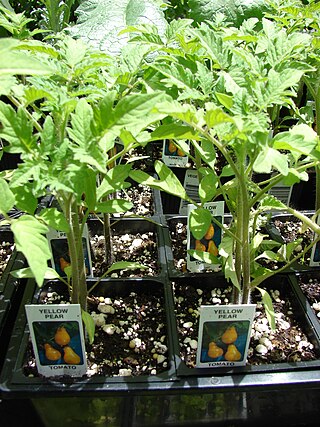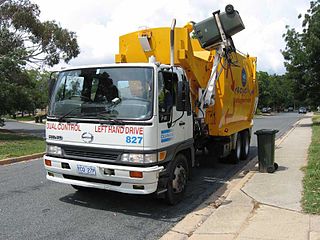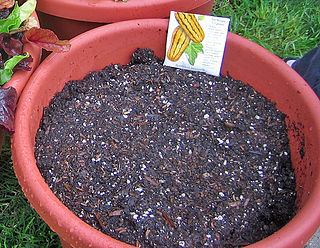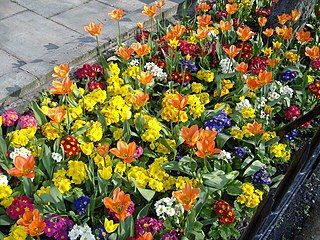
Raised-bed gardening is a form of gardening in which the soil is raised above ground level and usually enclosed in some way. Raised bed structures can be made of wood, rock, concrete or other materials, and can be of any size or shape. The soil is usually enriched with compost.

Bonsai is the Japanese art of growing and shaping miniature trees in containers, developed from the traditional Chinese art form of penjing. While both penjing and bonsai involve the cultivation of miniature trees, they differ in that penjing overall aims to showcase "wilder," more naturalistic scenes and encompasses a wider range of styles and designs, and may include various elements such as rocks, water features, and figurines, creating a more elaborate and dynamic scene; on the other hand, bonsai is more restrictively focused on a single tree or a group of trees of the same species, with a higher level of aesthetic refinement. Similar versions of the art exist in other cultures, including the miniature living landscapes of Vietnamese Hòn non bộ. During the Tang dynasty, when penjing was at its height, the art was first introduced from China.

A mulch is a layer of material applied to the surface of soil. Reasons for applying mulch include conservation of soil moisture, improving fertility and health of the soil, reducing weed growth, and enhancing the visual appeal of the area.

A watering can is a portable container, usually with a handle and a funnel, used to water plants by hand. It has been in use since at least A.D. 79 and has since seen many improvements in design. Apart from watering plants, it has varied uses, as it is a fairly versatile tool.

Plugs in horticulture are small-sized seedlings grown in seed trays filled with potting soil. This type of plug is used for commercially raising vegetables and bedding plants. Similarly plugs may also refer to small sections of lawn grass sod. After being planted, lawn grass may somewhat spread over an adjacent area.

In agriculture and gardening, transplanting or replanting is the technique of moving a plant from one location to another. Most often this takes the form of starting a plant from seed in optimal conditions, such as in a greenhouse or protected nursery bed, then replanting it in another, usually outdoor, growing location. The agricultural machine that does this is called a transplanter. This is common in market gardening and truck farming, where setting out or planting out are synonymous with transplanting. In the horticulture of some ornamental plants, transplants are used infrequently and carefully because they carry with them a significant risk of killing the plant.

Container gardening or pot gardening/farming is the practice of growing plants, including edible plants, exclusively in containers instead of planting them in the ground. A container in gardening is a small, enclosed and usually portable object used for displaying live flowers or plants. It may take the form of a pot, box, tub, basket, tin, barrel or hanging basket.

Kerbside collection or curbside collection is a service provided to households, typically in urban and suburban areas, of collecting and disposing of household waste and recyclables. It is usually accomplished by personnel using specially built vehicles to pick up household waste in containers that are acceptable to, or prescribed by, the municipality and are placed on the kerb.

The floral industry is focused on the production, distribution and sale of flowers for human enjoyment. The floral industry began in the Golden Century of the Netherlands, where flowers were grown on a large scale on vast estates. The industry continues to diversify from the production of cut flowers to the production and sale of plants and flowers in many different forms. The global floral industry market size is estimated to be worth US$ 50040 million in 2022 and is forecast to increase to US$ 58030 million by 2028 with a compound annual growth rate of 2.5% during the review period.
An olla is a ceramic jar, often unglazed, used for cooking stews or soups, for the storage of water or dry foods, or for other purposes like the irrigation of olive trees. Ollas have short wide necks and wider bellies, resembling beanpots or East Indian matki.

Ebb and flow hydroponics is a form of hydroponics that is known for its simplicity, reliability of operation and low initial investment cost. Pots are filled with an inert medium which does not function like soil or contribute nutrition to the plants but which anchors the roots and functions as a temporary reserve of water and solvent mineral nutrients. The hydroponic solution alternately floods the system and is allowed to ebb away.

A potting bench or gardening table is a kind of workbench used for small gardening tasks such as transplanting seedlings. A basic potting bench has a work surface at bench height, comfortable for a standing person; and storage for potting soil, pots, and tools. The same furniture is often also used to display potted plants, even indoors.

Potting soil or growing media, also known as potting mix or potting compost (UK), is a substrate used to grow plants in containers. The first recorded use of the term is from an 1861 issue of the American Agriculturist. Despite its name, little or no soil is usually used in potting soil.

Many types of flowering plants are available to plant in flower gardens or flower beds. The floral industry calls these plants, bedding plants. These fast-growing plants in seasonal flower beds create colourful displays, during spring, summer, fall or winter, depending on the climate. Plants used for bedding are generally annuals, but biennials, tender perennials, and succulents are used.

Many pot designs train the roots. One example is a truncated plastic cone in which a seedling is planted. There is a drainage hole at the bottom and the main tap root tends to grow towards this.

Bonsai cultivation and care involves the long-term cultivation of small trees in containers, called bonsai in the Japanese tradition of this art form. Similar practices exist in other Japanese art forms and in other cultures, including saikei (Japanese), penjing (Chinese), and hòn non bộ (Vietnamese). Trees are difficult to cultivate in containers, which restrict root growth, nutrition uptake, and resources for transpiration. In addition to the root constraints of containers, bonsai trunks, branches, and foliage are extensively shaped and manipulated to meet aesthetic goals. Specialized tools and techniques are used to protect the health and vigor of the subject tree. Over time, the artistic manipulation of small trees in containers has led to a number of cultivation and care approaches that successfully meet the practical and the artistic requirements of bonsai and similar traditions.
There are many ways to garden in restricted spaces. Often a small or limited space is an issue in growing and cultivating plants. Restricted space gardens can be located on small lawns, balconies, patios, porches, rooftops, inside the home, or in any other available place. Gardening in small places can be applied to edible or floral plants. Growing food has many benefits including saving money; healthier, fresher, and better tasting food; knowledge of pesticide and fertilizer exposure. Gardening is a good form of exercise and has been proven to be therapeutic.

A cachepot is a French term for what is usually called in modern English a "planter" or for older examples a jardiniere, namely a decorative container or "overpot" for a plant and its flowerpot, for indoors use, usually with no drainage hole at the bottom, or sometimes with a matching saucer. It is intended to be more attractive than the terracotta flowerpot in which the plant grows, and to keep water off furniture surfaces.

Micro-irrigation, also called Micro-spray,localized, low-volume, low-flow, or trickle irrigation, is an irrigation method with lower water pressure and flow than a traditional sprinkler system. Low-volume irrigation is used in agriculture for row crops, orchards, and vineyards. It is also used in horticulture in wholesale nurseries, in landscaping for civic, commercial, and private landscapes and gardens, and in the science and practice of restoration ecology and environmental remediation. The lower volume allows the water to be absorbed into slow-percolation soils such as clay, minimizing runoff.


























